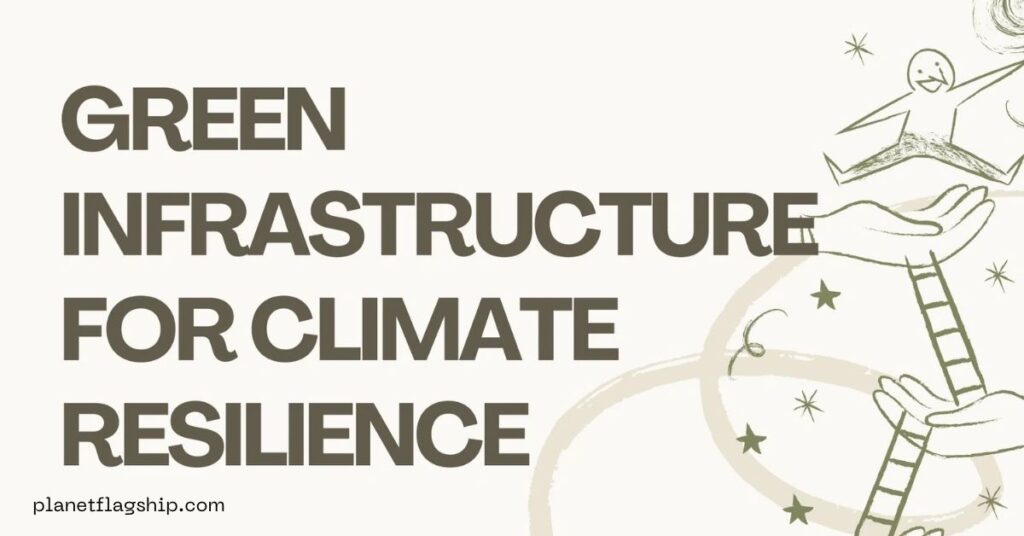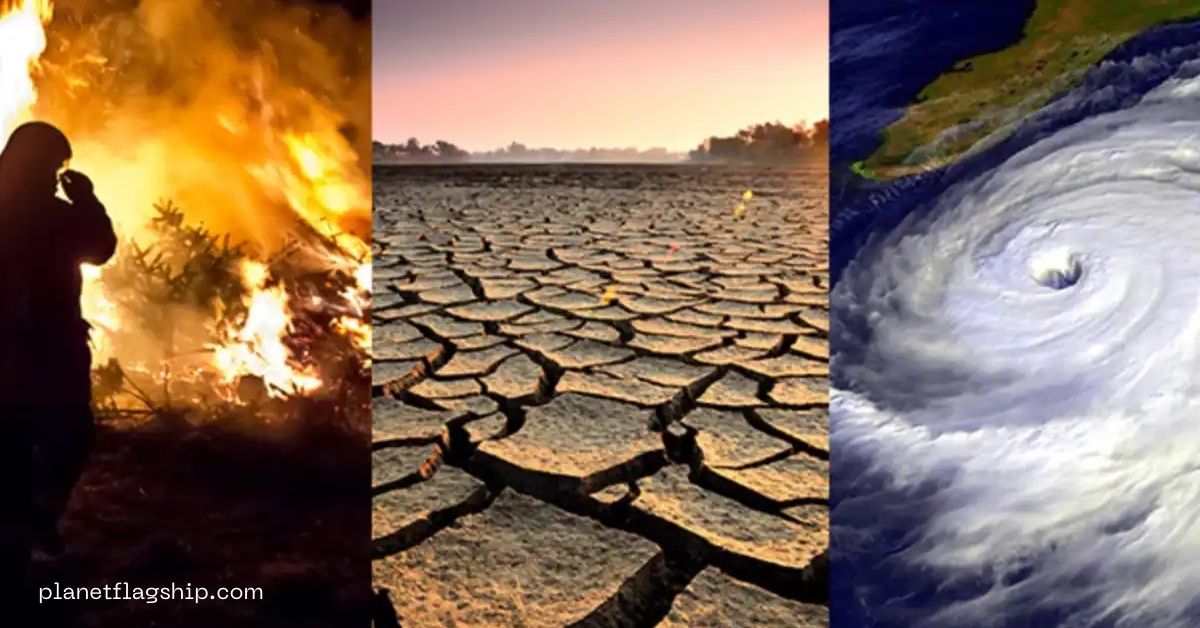In recent years, Pakistan has faced the reality of climate change. From deadly heatwaves in Karachi to devastating floods across Sindh and Punjab, extreme weather is no longer a future threat; it is happening now.
In 2022 alone, record-breaking floods affected over 33 million people, destroying homes, livelihoods, and infrastructure (World Bank, 2023).in this we talk about How Cities Can Prepare for Climate Change. As climate disasters become more frequent and intense, the question for Pakistan’s cities is not if they will be affected but how prepared they will be when disaster strikes.
Urban Areas on the Frontlines
Pakistan’s cities are growing fast. Urban areas such as Karachi, Lahore, Islamabad, and Peshawar are home to millions, with an increasing number of people moving in every year. But these cities are also climate hotspots. Dense populations, poor planning, and outdated infrastructure make them extremely vulnerable to heatwaves, heavy rains, and air pollution (Ali & Nawaz, 2022).
At the same time, cities have the potential to lead the way in climate action. Local governments can act quickly. Communities can come together. With the right investment and leadership, urban areas can shift from being victims of climate change to champions of resilience.
Redesigning Infrastructure for Climate Resilience

Much of Pakistan’s urban infrastructure was not designed to withstand today’s climate. Streets often flood after only a few hours of rain. Power outages are common during heat waves. Many buildings, however, are not designed to withstand extreme weather.
To address this, cities need to reassess their approach to building and maintaining infrastructure. For example, stormwater drainage systems should be upgraded to handle heavier rainfall. In Lahore, local officials have utilized underground water tanks to mitigate flooding in densely populated areas (LDA, 2021). Karachi, which suffers from urban flooding every monsoon, needs improved waste management and better water channels to prevent blockages (Hasan, 2020).
Incorporating green infrastructure is just as important. Planting trees, creating urban wetlands, and using permeable pavements can reduce flood risk and cool down urban areas (UN-Habitat, 2021).
READ MORE: Human Cost of Climate Change: how it’s displacing millions of people?
Keeping the Power On During Crises
Pakistan’s energy grid is fragile. Power shortages are common even in the absence of disasters. During extreme heat, demand for electricity increases, putting more pressure on a system that is already struggling.
One solution is to invest in solar energy and microgrids. These are small, local power systems that can operate independently when the main grid fails. For instance, some schools and hospitals in rural Sindh are already utilizing solar panels to maintain electricity during emergencies (IRENA, 2022). Expanding these systems to urban neighborhoods would help ensure that vital services stay available when disaster hits.
Protecting the Most Vulnerable
Climate change affects everyone, but not equally. Low-income families living in informal settlements, older people, children, and people with disabilities often face the greatest risks. Their homes may be poorly constructed, their access to healthcare limited, and their ability to evacuate during disasters low.
Cities must prioritize these groups. For example, establishing cooling centers during heat waves, providing early warnings in local languages, and making public shelters accessible to all can save lives. Community outreach programs, particularly those led by local NGOs, have already demonstrated success in cities such as Karachi and Islamabad (Shah, 2021).
Few examples of community involvement
Solutions must come from the people who live in these cities. Community members understand their neighborhoods better than anyone. Cities like Rotterdam and Boston have proven that involving citizens in planning leads to stronger, more trusted climate strategies (City of Boston, 2022).
In Pakistan, initiatives such as urban forest planting in Islamabad and community-led flood mapping in parts of Sindh are promising beginnings (WWF-Pakistan, 2022). More cities should establish platforms, such as town hall meetings, climate workshops, or digital apps, for citizens to share ideas and contribute to shaping local policies.
Urban Areas: The Center of the Climate Challenge
Cities play a major role in climate change. They bring together large populations, buildings, roads, and vehicles—all of which produce heat and carbon emissions. Their paved streets and sidewalks do not absorb water, thereby increasing the risk of flooding. When you add rising sea levels, stronger storms, and aging infrastructure to the mix, cities face serious risks (Intergovernmental Panel on Climate Change [IPCC], 2021).
But cities also have a unique strength: they can adapt quickly. Local governments can make decisions more quickly than national ones. Cities also have strong communities, access to funding, and plenty of new ideas. With smart planning and effective leadership, cities can transition from being vulnerable to becoming leaders in combating climate change (C40 Cities, n.d.).
Rebuilding for the Climate of Today
Most city infrastructure, such as roads, bridges, power lines, and drains, was built many decades ago. It was not made to handle today’s climate. For example, storms that used to occur once every 100 years are now happening much more frequently. Cities are also facing longer heat waves and heavier rainfall (IPCC, 2021).
That is why many cities are upgrading. In Miami, for instance, engineers are raising streets, using pumps to push floodwater back into the sea, and updating building codes to handle new climate risks (City of Miami, 2023). In New York, the “Big U” project is creating a large barrier to protect Lower Manhattan from flooding. At the same time, it will serve as a public space for parks and recreation (U.S. Department of Housing and Urban Development [HUD], 2022).
But fighting climate change is not just about using concrete and steel. Increasingly, cities are adopting green infrastructure solutions that work in harmony with nature, rather than against it. Singapore, for example, is building “sponge cities” with parks, green roofs, and pavements that allow rainwater to soak in. These changes help reduce floods, cool the city, and make it a more pleasant place to live (World Bank, 2021).
Cooling Down the Urban Heat Island

Cities often feel much hotter than the nearby countryside, sometimes by as much as 10°F. This phenomenon is known as the urban heat island effect. The primary causes are dark rooftops, black asphalt, and insufficient tree and plant coverage, which absorb and release heat throughout the day (U.S. Environmental Protection Agency [EPA], 2023).
To combat this, numerous cities are devising innovative solutions. Los Angeles is testing out “cool pavement”, a light-colored road coating that reflects sunlight and lowers the temperature of streets (City of Los Angeles, 2022). In Melbourne, Australia, city leaders aim to increase tree coverage by 40% by 2040. This additional greenery will help naturally cool down neighborhoods (City of Melbourne, 2021).
Paris acted after a deadly heatwave in 2003. The city created “cooling islands” where people can go to escape the heat. These include shaded parks, misting stations, and air-conditioned public spaces. The locations are listed in an app, allowing residents to find relief during heat waves (City of Paris, 2023).
Making Homes Safer During Disasters
A home should be a safe place during a disaster, but for many, it is not. In cities, especially in poorer neighborhoods, homes often trap heat, flood easily, or lack air conditioning and clean water. These problems can turn a heatwave or hurricane into a life-threatening situation (United Nations Human Settlements Programme [UN-Habitat], 2021).
However, making homes more resilient does not have to be costly. In Chennai, India, local architects are helping residents raise their homes and add simple flood barriers made from recycled materials (World Bank, 2020). In New Orleans, following Hurricane Katrina, new homes are being built on raised platforms that incorporate solar panels and rainwater storage into their design (Federal Emergency Management Agency [FEMA], 2022).
Many of these improvements are led by local communities. Grassroots groups and neighborhood organizations ensure that resilience encompasses everyone, particularly the most vulnerable. At its core, resilience is not just about buildings; it is about fairness and access (UN-Habitat, 2021).
Crisis-Proof Transportation
When a disaster strikes, having a way to escape or reach help can save lives. But in various cities, traffic jams, broken subways, or limited transportation options leave people stranded during floods, wildfires, or storms.
Some cities are preparing better. Tokyo, for example, has overlapping transportation systems—like bullet trains, subways, and bike lanes. If one shuts down, others continue to operate (Tokyo Metropolitan Government, 2022). San Francisco is upgrading its buses to electric models, not only to reduce pollution but also because electric buses can continue to operate during power outages (San Francisco Municipal Transportation Agency [SFMTA], 2023).
Good planning is just as important as good vehicles. Cities need to design evacuation routes, provide real-time transit information, and have special services for elderly or disabled residents. These steps ensure everyone can move safely in an emergency (FEMA, 2022).
FAQ’s
Why are cities more vulnerable to climate change than rural areas?
Cities concentrate people, buildings, and infrastructure, making them hotspots for heatwaves, floods, and pollution. Poor planning and outdated systems worsen the risks. Their dense layout leaves little room for nature to absorb shocks like heavy rain or rising heat.
How can cities reduce flooding risks?
Cities can upgrade stormwater systems, build underground tanks, and improve waste management to prevent clogged drains. Adding green infrastructure like urban wetlands, permeable pavements, and tree planting helps absorb excess water. These steps reduce damages and keep neighborhoods safer.
What role does renewable energy play in climate-resilient cities?
Renewable energy like solar panels and microgrids keeps power running when the main grid fails during disasters. Schools and hospitals in Pakistan already use solar for emergencies. Expanding such systems ensures essential services continue even in extreme weather.
How can cities protect vulnerable groups during disasters?
Low-income families, elderly, and disabled residents face higher risks in heatwaves and floods. Cities should set up cooling centers, accessible shelters, and local-language alerts. Community outreach and NGO-led programs make resilience inclusive and life-saving.
What are some global examples of climate-smart urban planning?
Miami raises streets and installs pumps to fight floods, while Singapore builds “sponge cities” with green roofs and parks. Paris created cooling islands with misting stations and shaded areas after deadly heatwaves. These models show how cities can adapt and thrive.
Conclusion
Cities stand at the frontline of climate change, facing floods, heatwaves, and rising sea levels with increasing urgency. Yet, they also hold the greatest potential to lead resilience and innovation. By upgrading infrastructure, adopting renewable energy, and prioritizing vulnerable communities, urban areas can transform from fragile hotspots into models of sustainability.
Global examples show that smart planning and green solutions work when paired with community involvement and strong leadership. The future of climate adaptation lies in our cities, and acting today ensures safer, healthier, and more resilient urban life for generations to come.
References
C40 Cities. (n.d.). Climate action in cities. https://www.c40.org
City of Miami. (2023). Miami forever climate ready strategy. https://www.miamigov.com
Intergovernmental Panel on Climate Change. (2021). Sixth assessment report. https://www.ipcc.ch/assessment-report/ar6
U.S. Department of Housing and Urban Development. (2022). The Big U: Lower Manhattan coastal resiliency project. https://www.hud.gov
World Bank. (2021). Nature-based solutions for urban resilience. https://www.worldbank.org
City of Los Angeles. (2022). Cool pavement program. https://streetsla.lacity.org/cool-pavement
City of Melbourne. (2021). Urban forest strategy. https://www.melbourne.vic.gov.au
City of Paris. (2023). Cool islands in Paris. https://www.paris.fr
Federal Emergency Management Agency. (2022). Building resilient communities. https://www.fema.gov
San Francisco Municipal Transportation Agency. (2023). Electric bus rollout. https://www.sfmta.com
Tokyo Metropolitan Government. (2022). Transportation resilience plan. https://www.metro.tokyo.lg.jp
United Nations Human Settlements Programme (UN-Habitat). (2021). Resilient housing solutions. https://unhabitat.org
U.S. Environmental Protection Agency. (2023). Urban heat island basics. https://www.epa.gov/heatislands
World Bank. (2020). Community-based flood resilience in Chennai. https://www.worldbank.org

John is a professional blogger and passionate advocate for environmental sustainability. With years of experience exploring eco-friendly practices and green innovations, he shares insightful articles on Planet Flagship to inspire a sustainable future. John’s expertise lies in making complex environmental topics accessible and actionable, empowering readers to make meaningful changes for the planet.
